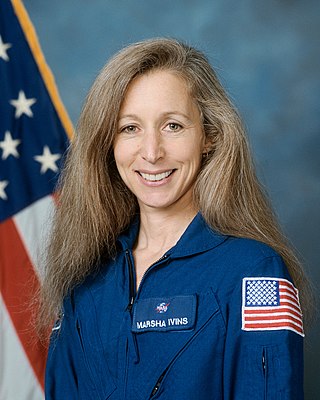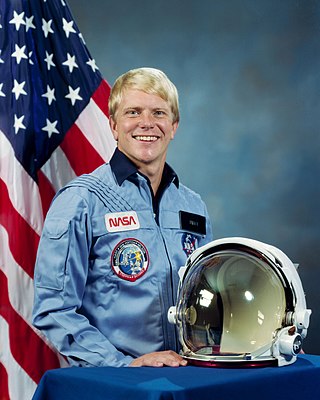
The Space Shuttle is a retired, partially reusable low Earth orbital spacecraft system operated from 1981 to 2011 by the U.S. National Aeronautics and Space Administration (NASA) as part of the Space Shuttle program. Its official program name was Space Transportation System (STS), taken from the 1969 plan led by U.S. Vice President for a system of reusable spacecraft where it was the only item funded for development, as nuclear shuttle in the plan was cancelled.

STS-9 was the ninth NASA Space Shuttle mission and the sixth mission of the Space Shuttle Columbia. Launched on November 28, 1983, the ten-day mission carried the first Spacelab laboratory module into orbit.

The Manned Maneuvering Unit (MMU) is an astronaut propulsion unit that was used by NASA on three Space Shuttle missions in 1984. The MMU allowed the astronauts to perform untethered extravehicular spacewalks at a distance from the shuttle. The MMU was used in practice to retrieve a pair of faulty communications satellites, Westar VI and Palapa B2. Following the third mission the unit was retired from use. A smaller successor, the Simplified Aid For EVA Rescue (SAFER), was first flown in 1994, and is intended for emergency use only.

NASA's Long Duration Exposure Facility, or LDEF, was a cylindrical facility designed to provide long-term experimental data on the outer space environment and its effects on space systems, materials, operations and selected spores' survival. It was placed in low Earth orbit by Space ShuttleChallenger in April 1984. The original plan called for the LDEF to be retrieved in March 1985, but after a series of delays it was eventually returned to Earth by Columbia in January 1990.

STS-32 was the 33rd mission of NASA's Space Shuttle program, and the ninth launch of Space ShuttleColumbia. Launched on January 9, 1990, it marked the first use of the Launch Complex 39A of Kennedy Space Center since 1986; it also marked the first use of Mobile Launcher Platform-3 (MLP-3) in the Space Shuttle program. STS-32 was, at the time, the longest shuttle mission yet conducted, with a duration of nearly 11 days. Before STS-32, the only mission of the same duration had been STS-9 in 1983. On January 20, 1990, STS-32 executed the third night landing of the shuttle program. STS-32 was also the first Shuttle mission of the 1990s.

STS-41-B was NASA's tenth Space Shuttle mission and the fourth flight of the Space ShuttleChallenger. It launched on February 3, 1984 and landed on February 11, 1984, after deploying two communications satellites. It was also notable for including the first untethered spacewalk.

Marsha Sue Ivins is an American retired astronaut and a veteran of five Space Shuttle missions.

STS-41-D was the 12th flight of NASA's Space Shuttle program, and the first mission of Space Shuttle Discovery. It was launched from Kennedy Space Center, Florida, on August 30, 1984, and landed at Edwards Air Force Base, California, on September 5, 1984. Three commercial communications satellites were deployed into orbit during the six-day mission, and a number of scientific experiments were conducted, including a prototype extendable solar array that would eventually form the basis of the main solar arrays on the International Space Station (ISS).

STS-51-A was the 14th flight of NASA's Space Shuttle program, and the second flight of Space Shuttle Discovery. The mission launched from Kennedy Space Center on November 8, 1984, and landed just under eight days later on November 16, 1984.

STS-51-I was the 20th mission of NASA's Space Shuttle program and the sixth flight of Space Shuttle Discovery. During the mission, Discovery deployed three communications satellites into orbit. The mission launched from Kennedy Space Center, Florida, on August 27, 1985, and landed at Edwards Air Force Base, California, on September 3, 1985.

STS-26 was the 26th NASA Space Shuttle mission and the seventh flight of the orbiter Discovery. The mission launched from Kennedy Space Center, Florida, on September 29, 1988, and landed four days later on October 3, 1988. STS-26 was declared the "Return to Flight" mission, being the first mission after the Space Shuttle Challenger disaster of January 28, 1986. It was the first mission since STS-9 to use the original Space Transportation System (STS) numbering system, the first to have all its crew members wear pressure suits for launch and landing since STS-4, and the first mission with bailout capacity since STS-4. STS-26 was also the first U.S. space mission with an all-veteran crew since Apollo 11, with all of its crew members having flown at least one prior mission.

STS-33 was a NASA Space Shuttle mission, during which Space Shuttle Discovery deployed a payload for the United States Department of Defense (DoD). It was the 32nd shuttle mission overall, the ninth flight of Discovery, the fifth shuttle mission in support of the DoD, the seventh post-Space Shuttle Challenger disaster mission and the last Shuttle mission of the 1980s. Due to the nature of the mission, specific details remain classified. Discovery lifted off from Launch Complex 39B at Kennedy Space Center (KSC), Florida, on November 22, 1989, at 7:23:30 p.m. EST; it landed at Edwards Air Force Base, California, on November 27, 1989, at 7:30:16 p.m. EST.

Richard Noel "Dick" Richards, , is a retired American naval officer and aviator, test pilot, chemical engineer, and a former NASA astronaut. He flew aboard four Space Shuttle missions in the 1980s and 1990s.

Daniel Charles Brandenstein is the Executive Vice President and Chief Operating Officer of United Space Alliance. He is a former Naval Aviator, test pilot and NASA astronaut, who flew four Space Shuttle missions. He also served as Chief of the Astronaut Office from 1987 to 1992.

George Driver "Pinky" Nelson is an American physicist, astronomer, science educator, and retired NASA astronaut.

James Dougal Adrianus "Ox" van Hoften is an American civil and hydraulic engineer, retired U.S. Navy officer and aviator, and a former astronaut for NASA.

Terry Jonathan "T. J." Hart is an American mechanical and electrical engineer, a retired United States Air Force lieutenant colonel and pilot, and former NASA astronaut. Hart served as a mission specialist on the STS-41-C mission, where tasks included operation of the shuttle Remote Manipulator System (RMS) arm to deploy the Long Duration Exposure Facility (LDEF) and Solar Max satellite.

The Solar Maximum Mission satellite was designed to investigate Solar phenomena, particularly solar flares. It was launched on February 14, 1980. The SMM was the first satellite based on the Multimission Modular Spacecraft bus manufactured by Fairchild Industries, a platform which was later used for Landsats 4 and 5 as well as the Upper Atmosphere Research Satellite.

The Dream is Alive is an American IMAX documentary film, released on June 1, 1985, about NASA's Space Shuttle program. The film was narrated by Walter Cronkite, and directed by Graeme Ferguson.

NASA Astronaut Group 10 was a group of 17 astronauts that were announced on May 23, 1984 and consisted of seven pilots and ten mission specialists. Although selected in 1984, no member of the group would fly until 1988 due to the Challenger disaster and the resulting grounding of the Space Shuttle fleet.





























